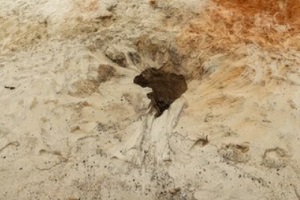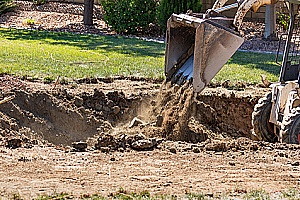 If you have found that having a swimming pool on your property is no longer worth the expense and effort involved in maintaining it, you may decide to have it removed. However, once your pool is gone, you will be left with an empty space in your yard that needs to be filled.
If you have found that having a swimming pool on your property is no longer worth the expense and effort involved in maintaining it, you may decide to have it removed. However, once your pool is gone, you will be left with an empty space in your yard that needs to be filled.
If you have enlisted the services of a professional pool removal company, they will leave your yard perfectly filled and leveled so that you can continue with your plans. However, if you are thinking about doing this on your own, you may wonder what is involved in the process of backfilling a pool.
What Is Backfilling A Pool?
In simple terms, backfilling a pool entails filling the empty space that was previously occupied by the pool with sand, dirt, gravel or a combination of these items. It is carried out after the concrete floor and walls of the pool have been broken up and removed in a full pool removal or after the top part of the shell has been broken down and placed inside the shell in a pool fill-in.
Although the area around your pool was probably backfilled when it was originally installed to fill in the space needed for installing its plumbing, backfilling a pool is usually discussed in the context of a pool removal.
Many times, a licensed engineer will oversee the pool removal process, particularly when you hire contractors for a full pool removal, and they will ensure that the area is suitable for additional structures and the ground is safe and stable.
However, some homeowners opt to take a different route and have the pool backfilled instead. This means they will be unable to build new structures on the area where the pool once stood, and they will also be required to disclose the fact that a pool previously existed there to potential buyers. However, this is a quicker and more affordable way to get an unwanted pool out of your yard so you can devote it to another use.
What Steps Are Involved In Filling In An Inground Swimming Pool?
First, all power is turned off to the pool by disconnecting the breaker box. The pool is then completely drained, and holes are drilled at the bottom of the pool to stop water from collecting inside of it. After this, the side walls are demolished starting at the top to enable the filled-in area to be flat.
 Then, the area is backfilled and compacted to prevent sinkholes from forming. During backfilling, the blade of an excavator is used to push dirt into the hole and the tracks are used to compact the dirt as much as possible. Then, three to six inches of topsoil are normally added to help establish a new lawn. The blade of the excavator is often used to grade the surface before the topsoil is spread. After this, you can begin planting your yard.
Then, the area is backfilled and compacted to prevent sinkholes from forming. During backfilling, the blade of an excavator is used to push dirt into the hole and the tracks are used to compact the dirt as much as possible. Then, three to six inches of topsoil are normally added to help establish a new lawn. The blade of the excavator is often used to grade the surface before the topsoil is spread. After this, you can begin planting your yard.
Pool Backfill Materials
Backfilling can be carried out with sand, dirt, gravel, or a combination of these depending on your budget and your intended use of the space.
Sand
Sand is often used to backfill the area surrounding a pool during its installation and may even be mixed with concrete to stop it from settling.
Dirt
Dirt is considered a suitable material for backfilling during a pool removal. Ideally, it will contain a ratio of 80 percent dirt and tailings and 20 percent topsoil.
Gravel
Gravel offers more efficient drainage and instant compaction because it settles immediately once it has been poured. Nevertheless, it will still need to be compacted to level the surface and fill in remaining gaps. The fact that gravel does not absorb water means it provides very efficient drainage.
Can You Backfill A Pool As A DIY Project?
Backfilling a pool on your own requires equipment such as an excavator with rubber tracks. For this reason, many people choose to hire professionals to carry out this step. Another aspect of backfilling a pool that can prove challenging for inexperienced homeowners is calculating the amount of backfill that is needed. This involves measuring the volume of the pool in cubic yards using measurements of its length, width and depth to ensure you order enough dirt to backfill the pool completely.
Another reason homeowners are discouraged from taking on this project is the fact that breaking up the walls and floors of the existing pool is a particularly dangerous step, especially if the pool is made of gunite. Drilling holes in the floor of the pool is also very complicated and can cause injury.
Backfilling A Pool Versus Full Pool Removal
 It is important to keep in mind that while backfilling a pool may be faster and cheaper than a full pool removal, there are several disadvantages to this technique. As previously discussed, in addition to being something that must be disclosed to future buyers of your home, it may have a negative impact on your home’s value when the time comes to sell because the area is considered non-buildable.
It is important to keep in mind that while backfilling a pool may be faster and cheaper than a full pool removal, there are several disadvantages to this technique. As previously discussed, in addition to being something that must be disclosed to future buyers of your home, it may have a negative impact on your home’s value when the time comes to sell because the area is considered non-buildable.
Moreover, if a future buyer wanted to install a new swimming pool in the area, they would first have to dig up and break out the pool shell and have the materials hauled away and then re-compact the soil and dig up the yard again to the shape of their new pool. This means that prospective homeowners who want a pool in their yard may not consider your home.
Moreover, when a pool fill-in is carried out incorrectly, there is a greater chance of major problems occurring in the yard, such as swelling, sinkage and a lack of proper seepage. This can require costly repairs.
Reach Out To The Pool Removal Specialists At Dirt Connections
Having a swimming pool removed is a major process that involves dangerous machinery and other hazards. Whether you are looking for a pool fill-in or a full pool removal, get in touch with the professional team at Dirt Connections to learn more about our Northern Virginia pool removal services.
Summary

Dirt Connections was started with one goal in mind: providing quality residential and commercial construction services to clients on time and on budget. Reach out for more information on how we can support your next project.
For your convenience our estimates are free and by appointment. Call 703-940-9949 for a free estimate today!









































